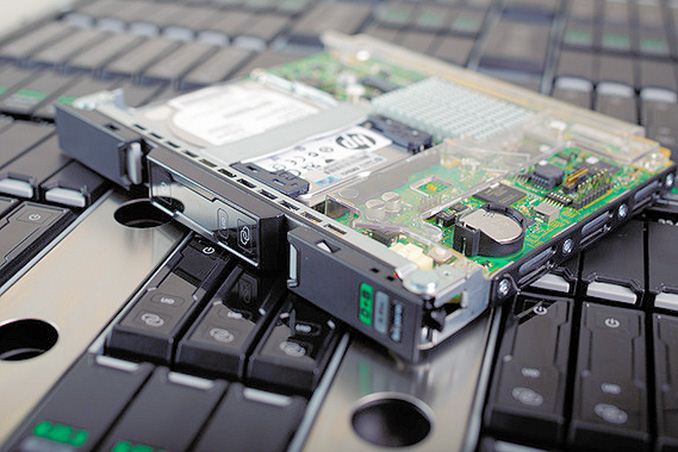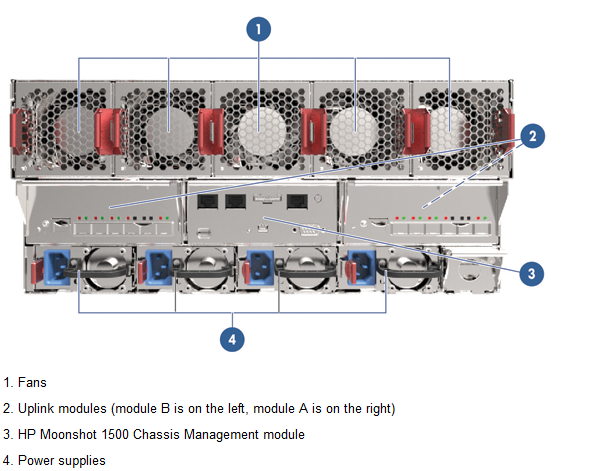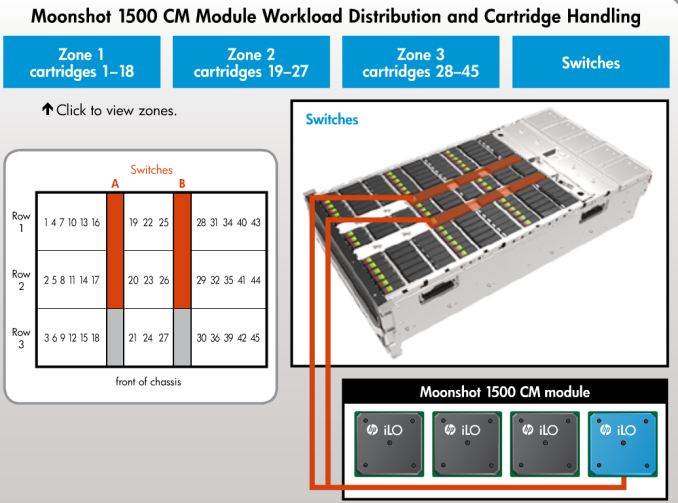Server Update April 2013: Positioning the HP Moonshot 1500
by Johan De Gelas on April 11, 2013 8:11 AM EST- Posted in
- Enterprise CPUs
- Arm
- Xeon
- Enterprise
- Calxeda
- S1200

HP is not shy of grand statements when it is describing its newest baby: "historic", "enables unprecedented scale" "revolutionary new architecture". HP claims "maximum density" and "unparalleled power efficiency". That of course, simply begs for closer inspection.
The HP Moonshot 1500 System chassis is a proprietary 4.3U chassis that is pretty heavy: 180 lbs or 81.6 Kg. The chassis hosts:
- 45 hot-pluggable Atom S1260 based server nodes
- A backplane with 3 different "fabrics": network, storage and cluster
- Two Ethernet switch modules
- Two uplink with SFPs
- a management module (with a sort of ILO "light")
- Two to four 1200W PSUs (94% efficient)
- 5 dual rotor, hot plug fans (N+1 redundancy)
Each server node has two 1 Gbit connections to one of the two Ethernet switch modules, or four Ethernet links in total. The cluster fabric allows a fast 2D Torus interconnect for linking up server nodes. The storage fabric is implemented but seems to be unused for now.
The two switch modules are located in the middle of the chassis, and are placed in the length of the backplane. They can be teamed up, but will probably end up in a redundant 1+1 configuration. The server nodes connect to the backplane by using PCI express slots, and also get their power from PCI Express pins, similar to what SeaMicro servers. All fans are located at the back of chassis.

The back is very similar to a blade chassis, with shared power, fans, management and uplink modules for all 45 server nodes.











26 Comments
View All Comments
pixelstuff - Thursday, April 11, 2013 - link
The acronyms were quite prolific in this article.WeaselITB - Thursday, April 11, 2013 - link
IDK, TLAs R AOK w/me.mayankleoboy1 - Thursday, April 11, 2013 - link
AFAIk, LZMA uses only two threads...LZMA2 can use as many as required. Can you do another benchmark, this time with LZMA2 algo, and set the number of threads to something big.
mayankleoboy1 - Thursday, April 11, 2013 - link
Nevermind, i thought you were testing on the complete thing, not only one node.JohanAnandtech - Thursday, April 11, 2013 - link
The benchmark actually spawns 4 threads if you instruct it to do that.mayankleoboy1 - Thursday, April 11, 2013 - link
Those 4 threads would be 4 processes, right ? Or a single process with 4 threads ?Kevin G - Thursday, April 11, 2013 - link
Any news of Intel's ISCCC coming to market? Even if performance is the same, it further integrates the various nodes further for greater density and the possibility of lower performance.Gigaplex - Thursday, April 11, 2013 - link
I wonder how AMDs Bobcat would compare in this scenario.Spunjji - Friday, April 12, 2013 - link
Probably average, not great at anything though as its PPW is probably lower than ARM in this scenario. That's mostly due to outdated process tech, though, so Jaguar might well be a nice competitor; even more so if people can figure out novel ways to use the GPU.fteoath64 - Wednesday, April 17, 2013 - link
The Atom is between a rock-and-a-hard-place. It is only good for consumer NAS devices and nothing really else. The Bobcat cores are worse in power consumption while 25% SLOWER than the Atom , so it is pretty useless, although its gpu is rather respectable at 80 cores. The low power Xeon Haswell is rather nice and should be developed (or sliced and diced) into the "New" Atom2 architecture, saving Intel the dearth of the Atom brand that has long since been dead and beaten over and over. There is no shame for Intel on this "dead horse". they kept beating it for all to see!.